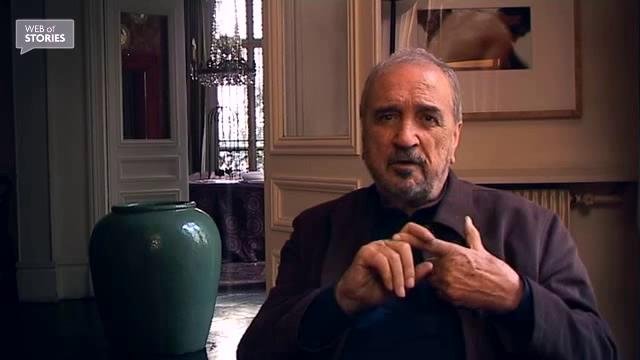NEXT STORY

A library should look like its owner
RELATED STORIES

NEXT STORY

A library should look like its owner
RELATED STORIES


|
Views | Duration | |
|---|---|---|---|
| 71. Keeping a 'book of deaths' | 141 | 02:19 | |
| 72. Storing memories | 138 | 01:19 | |
| 73. A scene observed but never used | 102 | 01:10 | |
| 74. Returning to my hotel wearing only one shoe | 183 | 01:23 | |
| 75. Editing-in the action | 157 | 01:16 | |
| 76. A library should look like its owner | 1 | 215 | 02:43 |
| 77. My drug of choice | 266 | 02:15 | |
| 78. Money: the giant octopus | 1 | 174 | 02:01 |
| 79. Expect everything from yourself | 1 | 236 | 01:31 |
| 80. 'Readiness is all' | 1 | 283 | 01:24 |

The editing called 'three seconds cut it' which is editing when there are no more than three seconds on the same frame, is used in a certain type of American action film. It is not used at all by the film-makers we like. Those we like edit the way that fits the story they want to tell. That trend, because that's what it is, going, '1,2,3, cut, 1,2,3, cut'... because if you just go '1,2' you simply don't see anything anymore – it is a fashion that makes you believe there is action where there isn't any. It puts the action in the camera rather than in the characters. If you take someone who... gets into a car, stops in front of a house, goes upstairs, opens a door, sits at his desk, there isn't any danger or threat - nothing happens but you have 18 frames. Just to make you believe that something has happened when nothing took place. It is illusion-editing. It is like cheating with film technique, putting action where there isn't any.
Le montage dit «3 seconds, cut it», le montage où il n’y a pas un plan qui dure plus de 3 seconds est un montage réservé à certains films dit « d’action américaines». Ce n’est pas du tout le cas pour les cinéastes que nous aimons. Les cinéastes que nous aimons font le montage qui convient à ce qu’ils veulent raconter. Cette mode là, parce que c’est une mode, on ne peut pas aller plus loin, c’est à dire: 1,2,3, cut, 1,2,3, cut… si on fait 1,2 on voit plus rien, on voit plus du tout le film. C’est une mode qui fait croire à l’existence d’une action là où il n’y en a pas. C’est à dire elle met l’action dans la camera et pas dans les personnages. Par exemple quelqu'un… arrive dans une voiture, s’arrête devant une maison, sort, rentre dans la maison, monte un escalier, ouvre une porte, s’assied dans son bureau, il n’a pas du tout ni de danger, ni de menace, rien ne se passe, vous avez 18 plans. Pour faire croire qu’il se passe quelque chose alors qui ne se passe rien. C’est un montage-illusion. C’est une forme de tricher avec la technique même du cinéma, c’est à dire de placer de l’action là où elle n’est pas.
French screenwriter Jean-Claude Carrière (1931-2021) began his association with films aged 24 when he was selected by Jacques Tati to write for him. This early experience led to further contact with other film-makers, including Luis Buñuel with whom Carrière collaborated for many years. He wrote screenplays for films including Belle de Jour, The Discreet Charms of the Bourgeoisie, Tin Drum and Danton.
Title: Editing-in the action
Listeners: Andrzej Wolski
Film director and documentary maker, Andrzej Wolski has made around 40 films since 1982 for French television, the BBC, TVP and other TV networks. He specializes in portraits and in historical films. Films that he has directed or written the screenplay for include Kultura, which he co-directed with Agnieszka Holland, and KOR which presents the history of the Worker’s Defence Committee as told by its members. Andrzej Wolski has received many awards for his work, including the UNESCO Grand Prix at the Festival du Film d’Art.
Tags: Film editing, action films, editing technique
Duration: 1 minute, 16 seconds
Date story recorded: January 2010
Date story went live: 10 May 2011